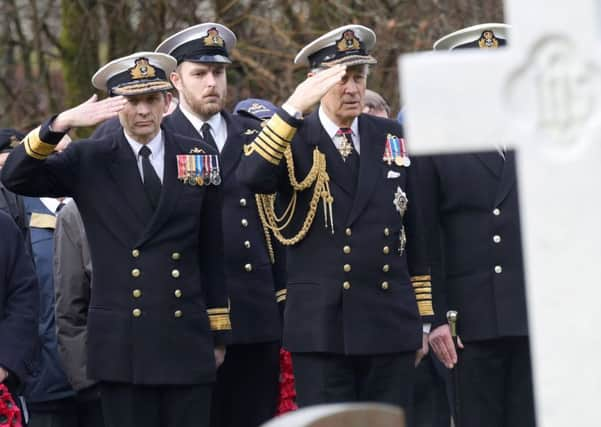K13 submarine disaster victims remembered at cenetenary service


Now, 100 years after the K13 submarine sank in the Gareloch, submariners and relatives of those who died have attended a ceremony to mark the disaster.
The steam-propelled vessel was undergoing its final tests on 29 January 1917 when seawater entered its engine room, causing an explosion. It sank, killing all of those in the engine room. Workers from Fairfields shipyard in Govan, which had built the vessel, were among the dead.
Advertisement
Hide AdAdvertisement
Hide AdVeterans, serving submariners from nearby HM Naval Base Clyde, representatives from the Commonwealth War Graves Commission (CWGC) and local Sea Cadets attended the ceremony at Faslane Cemetery in Garelochhead, Argyll and Bute, yesterday.
Some of the relatives of the 32 men who died in the disaster and who are buried at the cemetery also attended.
Jim McMaster, chairman of the Submariners’ Association, which organised the centenary event, said he wanted to remember both the bravery and tragedy of the incident.
He said: “It is right and proper that we remember those who have gone before us, the brave men who earned the reputation we enjoy today.
“It is natural that we commemorate those 32 unfortunate men who died in this accident but we should not lose sight of the fact that this was also a very successful submarine rescue for 48 men. Even by today’s standard, this is a major achievement.”
The testing initially appeared to be going well, but as the submarine began to submerge, men working in the boiler room reported flooding. An Admiralty Inquiry later found ventilators over the boiler room open, indicators in the boiler room set open and the engine-room hatch undone.
The crew of K13 were trapped beneath the icy waters of the Gareloch for some 57 hours before help arrived.
The captain, Lieutenant Commander Godfrey Herbert, and K14’s captain, Commander Francis Goodhart, made a desperate attempt to escape the stricken submarine in order to get help.
Advertisement
Hide AdAdvertisement
Hide AdThe pair used the space between the inner and outer hatches as an airlock, but only Mr Herbert made it to the surface alive as Mr Goodhart died after striking his head during the escape.
An airline was eventually attached to the vessel allowing the submarine to bring her bow to the surface where a hole was cut allowing the survivors to be rescued. However, by that time 32 submariners had already died.
The service ended with a march to the grave of Cdr Goodhart.
Shirley Thomas and her family, who travelled from Sheffield for the occasion, were also at the service. Her great-grandfather, Fred Porter, was a 37-year-old submariner who died on board K13.
She said: “We’ve always wanted to come up and pay our respects and the 100th anniversary seemed like the ideal time.”
K13 was raised from the Gareloch in March the same year and returned to service seven months later as HMS K22.
Since the tragedy, no Royal Navy vessel has borne the number 13.